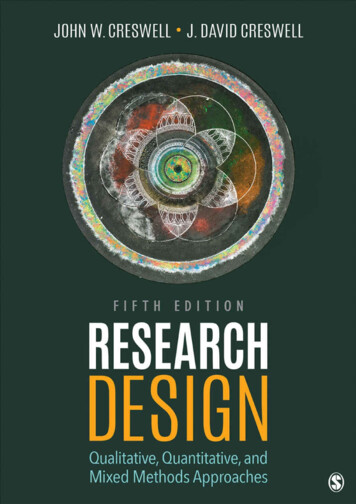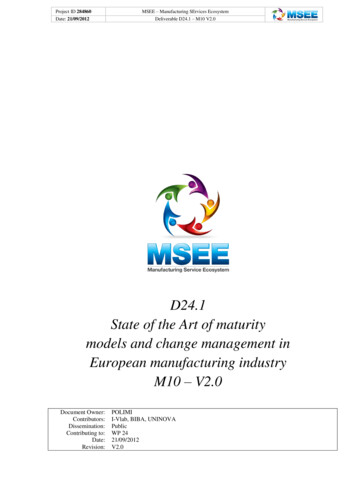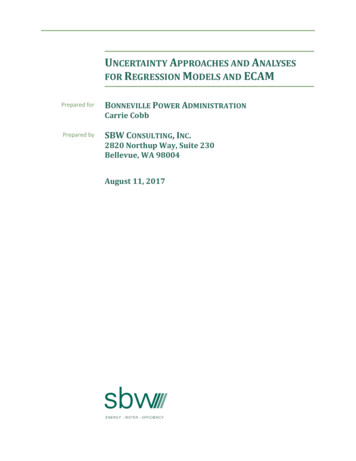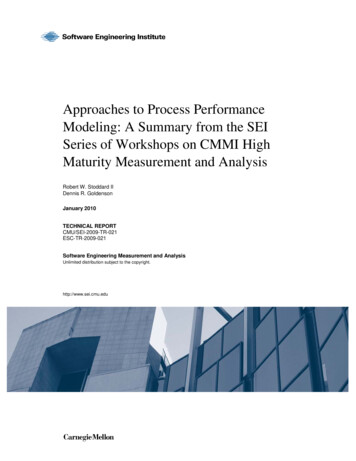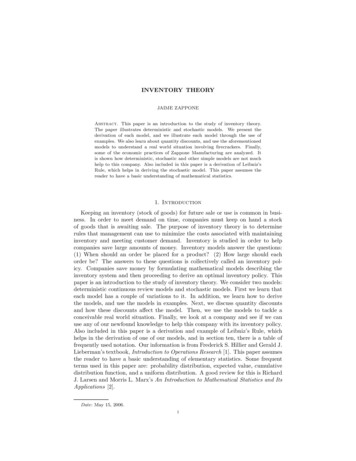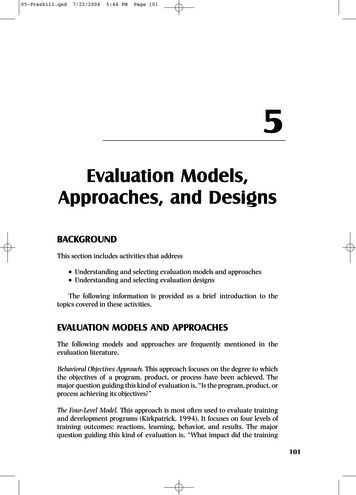
Transcription
05-Preskill.qxd7/22/20045:44 PMPage 1015Evaluation Models,Approaches, and DesignsBACKGROUNDThis section includes activities that address Understanding and selecting evaluation models and approaches Understanding and selecting evaluation designsThe following information is provided as a brief introduction to thetopics covered in these activities.EVALUATION MODELS AND APPROACHESThe following models and approaches are frequently mentioned in theevaluation literature.Behavioral Objectives Approach. This approach focuses on the degree to whichthe objectives of a program, product, or process have been achieved. Themajor question guiding this kind of evaluation is, “Is the program, product, orprocess achieving its objectives?”The Four-Level Model. This approach is most often used to evaluate trainingand development programs (Kirkpatrick, 1994). It focuses on four levels oftraining outcomes: reactions, learning, behavior, and results. The majorquestion guiding this kind of evaluation is, “What impact did the training101
05-Preskill.qxd7/22/20045:44 PMPage 102102—BUILDING EVALUATION CAPACITYhave on participants in terms of their reactions, learning, behavior, andorganizational results?”Responsive Evaluation. This approach calls for evaluators to be responsive tothe information needs of various audiences or stakeholders. The major question guiding this kind of evaluation is, “What does the program look like todifferent people?”Goal-Free Evaluation. This approach focuses on the actual outcomes ratherthan the intended outcomes of a program. Thus, the evaluator has minimalcontact with the program managers and staff and is unaware of the program’sstated goals and objectives. The major question addressed in this kind of evaluation is, “What are all the effects of the program, including any side effects?”Adversary/Judicial Approaches. These approaches adapt the legal paradigm toprogram evaluation. Thus, two teams of evaluators representing two viewsof the program’s effects argue their cases based on the evidence (data)collected. Then, a judge or a panel of judges decides which side has made abetter case and makes a ruling. The question this type of evaluation addressesis, “What are the arguments for and against the program?”Consumer-Oriented Approaches. The emphasis of this approach is to helpconsumers choose among competing programs or products. ConsumerReports provides an example of this type of evaluation. The major questionaddressed by this evaluation is, “Would an educated consumer choose thisprogram or product?”Expertise/Accreditation Approaches. The accreditation model relies on expertopinion to determine the quality of programs. The purpose is to provideprofessional judgments of quality. The question addressed in this kind ofevaluation is, “How would professionals rate this program?”Utilization-Focused Evaluation. According to Patton (1997), “utilizationfocused program evaluation is evaluation done for and with specific,intended primary users for specific, intended uses” (p. 23). As such, itassumes that stakeholders will have a high degree of involvement in many, ifnot all, phases of the evaluation. The major question being addressed is,“What are the information needs of stakeholders, and how will they use thefindings?”Participatory/Collaborative Evaluation. The emphasis of participatory/collaborative forms of evaluation is engaging stakeholders in the evaluationprocess, so they may better understand evaluation and the program beingevaluated and ultimately use the evaluation findings for decision-making
05-Preskill.qxd7/22/20045:44 PMPage 103EVALUATION MODELS, APPROACHES, AND DESIGNS—103purposes. As with utilization-focused evaluation, the major focusingquestion is, “What are the information needs of those closest to the program?”Empowerment Evaluation. This approach, as defined by Fetterman (2001), isthe “use of evaluation concepts, techniques, and findings to foster improvement and self-determination” (p. 3). The major question characterizing thisapproach is, “What are the information needs to foster improvement andself-determination?”Organizational Learning. Some evaluators envision evaluation as a catalyst forlearning in the workplace (Preskill & Torres, 1999). Thus, evaluation can beviewed as a social activity in which evaluation issues are constructed by andacted on by organization members. This approach views evaluation as ongoing and integrated into all work practices. The major question in this case is,“What are the information and learning needs of individuals, teams, and theorganization in general?”Theory-Driven Evaluation. This approach to evaluation focuses on theoreticalrather than methodological issues. The basic idea is to use the “program’srationale or theory as the basis of an evaluation to understand the program’sdevelopment and impact” (Smith, 1994, p. 83). By developing a plausiblemodel of how the program is supposed to work, the evaluator can considersocial science theories related to the program as well as program resources,activities, processes, and outcomes and assumptions (Bickman, 1987).The major focusing questions here are, “How is the program supposed towork? What are the assumptions underlying the program’s development andimplementation?”Success Case Method. This approach to evaluation focuses on the practicalities of defining successful outcomes and success cases (Brinkerhoff, 2003)and uses some of the processes from theory-driven evaluation to determinethe linkages, which may take the form of a logic model, an impact model, ora results map. Evaluators using this approach gather stories within the organization to determine what is happening and what is being achieved. Themajor question this approach asks is, “What is really happening?”EVALUATION DESIGNSEvaluation designs that collect quantitative data fall into one of threecategories:1. Preexperimental2. Quasi-experimental3. True experimental designs
05-Preskill.qxd7/22/20045:44 PMPage 104104—BUILDING EVALUATION CAPACITYThe following are brief descriptions of the most commonly used evaluation(and research) designs.One-Shot Design. In using this design, the evaluator gathers data followingan intervention or program. For example, a survey of participants might beadministered after they complete a workshop.Retrospective Pretest. As with the one-shot design, the evaluator collects data atone time but asks for recall of behavior or conditions prior to, as well as after, theintervention or program.One-Group Pretest-Posttest Design. The evaluator gathers data prior to andfollowing the intervention or program being evaluated.Time Series Design. The evaluator gathers data prior to, during, and after theimplementation of an intervention or program.Pretest-Posttest Control-Group Design. The evaluator gathers data on twoseparate groups prior to and following an intervention or program. Onegroup, typically called the experimental or treatment group, receives theintervention. The other group, called the control group, does not receive theintervention.Posttest-Only Control-Group Design. The evaluator collects data from two separategroups following an intervention or program. One group, typically called theexperimental or treatment group, receives the intervention or program, while theother group, typically called the control group, does not receive the intervention.Data are collected from both of these groups only after the intervention.Case Study Design. When evaluations are conducted for the purpose ofunderstanding the program’s context, participants’ perspectives, the innerdynamics of situations, and questions related to participants’ experiences,and where generalization is not a goal, a case study design, with an emphasison the collection of qualitative data, might be most appropriate. Case studiesinvolve in-depth descriptive data collection and analysis of individuals,groups, systems, processes, or organizations. In particular, the case studydesign is most useful when you want to answer how and why questions andwhen there is a need to understand the particulars, uniqueness, and diversity of the case.RETURN-ON-INVESTMENT DESIGNSMany evaluations, particularly those undertaken within an organizationalsetting, focus on financial aspects of a program. Typically in such evaluations,
05-Preskill.qxd7/22/20045:44 PMPage 105EVALUATION MODELS, APPROACHES, AND DESIGNS—105the questions involve a program’s “worth.” Four primary approaches includecost analysis, cost-benefit analysis, cost-effectiveness analysis, and return oninvestment (ROI).Cost analysis involves determining all of the costs associated with aprogram or an intervention. These need to include trainee costs (time, travel,and productivity loss), instructor or facilitator costs, materials costs, facilitiescosts, as well as development costs. Typically, a cost analysis is undertaken todecide among two or more different alternatives for a program, such as comparing the costs for in-class delivery versus online delivery.Cost analyses examine only costs. A cost-effectiveness analysis determines the costs as well as the direct outcomes or results of the program. Aswith cost analyses, the costs are measured in dollars or some other monetary unit. The effectiveness measure may include such things as reducederrors or accidents, improved customer satisfaction, and new skills. Thedecision maker must decide whether the costs justify the outcomes.A cost-benefit analysis transforms the effects or results of a program intodollars or some other monetary unit. Then the costs (also calculated in monetary terms) can be compared to the benefits. As an example, let us assumethat a modification in the production system is estimated to reduce errors by10%. Given that production errors cost the company 1,000,000 last year,the new system should save the company 100,000 in the first year and thesucceeding year. Assuming that the modification would cost 100,000 andthe benefits would last for 3 years, we can calculate the benefit/cost ratio asfollows:Benefit/cost ratio Program benefits/program costsBenefit/cost ratio 300,000/ 100,000Benefit/cost ratio 3:1This means that for each dollar spent, the organization would realizethree dollars of benefits.The ROI calculation is often requested by executives. Using the previousexample, the formula is as follows:ROI [Net program benefits/Program costs] 100%ROI [(Program benefits – Program costs)/Program costs] 100%ROI [( 300,000 – 100,000)/ 100,000] 100%ROI [ 200,000/ 100,000] 100%ROI 2 100%ROI 200%
05-Preskill.qxd7/22/20045:44 PMPage 106106—BUILDING EVALUATION CAPACITYThis means that the costs were recovered, and an additional 200% of thecosts were returned as benefits.RESOURCESAlkin, M. C. (Ed.). (2004). Evaluation roots: Tracing theorists’ views and influences. Thousand Oaks, CA: Sage.Bickman, L. (1987). The function of program theory. In P. J. Rogers,T. A. Haccsi, A. Petrosino, & T. A. Huebner (Eds.), Using program theory ineducation (New Directions for Program Evaluation, Vol. 33, pp. 5-18).San Francisco: Jossey Bass.Bloom, B. S., Engelhart, M. D., Furst, E. J., Hill, W. H., & Krathwohl, D. R.(1956). Taxonomy of educational objectives: Handbook I: Cognitive domain.New York: David McKay.Brigham, E. F., Gapenski, L. C., & Ehrhart, M. C. (1998). Financial management:Theory and practice (9th ed.). New York: Thomson.Brinkerhoff, R. O. (2003). The success case method: Find out quickly what’sworking and what’s not. San Francisco: Berrett-Koehler.Chen, H. T. (1990). Theory-driven evaluations. Newbury Park, CA: Sage.Cousins, J. B., & Whitmore, E. (1998). Framing participatory evaluation.In E. Whitmore (Ed.), Understanding and practicing participatory evaluation (New Directions for Evaluation, Vol. 80, pp. 5-23). San Francisco:Jossey-Bass.Fetterman, D. M. (2001). Foundations of empowerment evaluation. ThousandOaks, CA: Sage.House, E. R. (1993). Professional evaluation: Social impact and political consequences. Thousand Oaks, CA: Sage.Kee, J. E. (1994). Benefit-cost analysis in program evaluation. In J. S. Wholey,H. P. Hatry, & K. E. Newcomer (Eds.), Handbook of practical program evaluation (pp. 456-488). San Francisco: Jossey-Bass.Kirkpatrick, D. (1994). Evaluating training programs: The four levels. SanFrancisco: Berrett-Koehler.Levin, H. M., & McEwan, P. J. (2001). Cost-effectiveness analysis: Methods andapplications (2nd ed.). Thousand Oaks, CA: Sage.Mager, R. F. (1962). Preparing instructional objectives. Palo Alto, CA: FearonPress.
05-Preskill.qxd7/22/20045:44 PMPage 107EVALUATION MODELS, APPROACHES, AND DESIGNS—107Mark, M. M., Henry, G. T., & Julnes, G. (2000). Evaluation: An integratedframework for understanding, guiding, and improving policies and programs.San Francisco: Jossey-Bass.Patton, M. Q. (1997). Utilization-focused evaluation: The new century text.Thousand Oaks, CA: Sage.Phillips, J. J. (1997). Return on investment in training and development programs.Houston, TX: Gulf Publishing.Preskill, H., & Torres, R. T. (1999). Evaluative inquiry for learning in organizations. Thousand Oaks, CA: Sage.Russ-Eft, D., & Preskill, H. (2001). Evaluation in organizations: A systematicapproach to learning, performance, and change. Boston: Perseus.Scriven, M. (1973). Goal-free evaluation. In E. R. House (Ed.), School evaluation (pp. 319-328). Berkeley, CA: McCutchan.Scriven, M. (1994). Product evaluation—The state of the art. EvaluationPractice, 15(1), 45-62.Shadish, W. R., Cook, T. D., & Leviton, L. C. (1995). Foundations of programevaluation: Theories of practice. Thousand Oaks, CA: Sage.Smith, N. L. (1994). Clarifying and expanding the application of programtheory-driven evaluations. Evaluation Practice, 15(1), 83-87.Stake, R. E. (1995). The art of case study research. Thousand Oaks, CA: Sage.Stake, R. E. (2004). Standards-based and responsive evaluation. Thousand Oaks,CA: Sage.Stufflebeam, D. L. (Ed.). (2001). Evaluation models (New Directions forEvaluation, Vol. 89). San Francisco: Jossey-Bass.Swanson, R. A., & Holton, E. F., III (1999). Results: How to assess performance,learning, and perceptions in organizations. San Francisco: Berrett-Koehler.Wolf, R. L. (1975). Trial by jury: A new evaluation method. Phi Delta Kappan,57, 185-187.Worthen, B. R., Sanders, J. R., & Fitzpatrick, J. L. (1997). Program evaluation:Alternative approaches and practice guidelines (2nd ed.). New York:Longman.Yin, R. K. (2002). Case study research: Design and methods (3rd ed.). ThousandOaks, CA: Sage.
05-Preskill.qxd7/22/20045:44 PMPage 108Activity 20Determining Whenand Where to Use VariousEvaluation Models and ApproachesOverviewThis activity provides participants with an understanding of variousevaluation models and approaches and how they can be used.Instructional ObjectivesParticipants will Describe the conditions under which certain evaluation models orapproaches may be most effective or appropriate Discuss the implications of using various evaluation models andapproaches for an evaluation study Discuss when and how one chooses to use a particular evaluationmodel or approachNumber of Participants Minimum number of participants: 3 Maximum number of participants: unlimited when participants are ingroups of 3 to 5Time Estimate: 45 to 60 minutesIn addition to providing the necessary background information on various evaluation models and approaches, this activity requires approximately45 to 60 minutes, depending on the number of participants (or groups) andthe time available for discussion.108
05-Preskill.qxd7/22/20045:44 PMPage 109EVALUATION MODELS, APPROACHES, AND DESIGNS—109Materials Needed Pens/pencils Flipchart, markers, tape Handout “Evaluation Models and Approaches”Instruction MethodSmall-group workProceduresFacilitator’s tasks: Ask participants to get into groups of three to five people. Depending on the number of groups, distributes one or two differenthandouts (models and approaches) to each group. Instruct participants, as a group, to complete the handout. Invite groups to share their ideas with the larger group. Ask otherparticipants to add their ideas if they worked on this model orapproach. Debrief the activity with the following questions:– Which models or approaches seem similar or compatible? In whatways are they similar or compatible?– Which models or approaches have different orientations? Howmight these differences manifest themselves in an evaluation?– Which of the models or approaches would fit within the context ofthe organization or organizations with which you typically work?– How do you think one decides which models and approaches to usefor any one evaluation? What criteria would you use to determinethe most appropriate model and approach for a given evaluationcontext?
05-Preskill.qxd7/22/20045:44 PMPage 110Evaluation Models and ApproachesHandout for Activity 20Behavioral ObjectivesThis approach focuses on the degree to which the objectives of a program,product, or process have been achieved. The major question guiding this kind ofevaluation is, “Is the program, product, or process achieving its objectives?”What are some examplesor situations in which youwould use this approach?What conditionsneed to exist to usethis approach?What aresome limitationsof this approach?Copyright 2005 Sage Publications. All rights reserved. Reprinted from Building EvaluationCapacity: 72 Activities for Teaching and Training by Hallie Preskill and Darlene Russ-Eft.Thousand Oaks, CA: Sage Publications, www.sagepub.com.110
05-Preskill.qxd7/22/20045:44 PMPage 111Evaluation Models and ApproachesHandout for Activity 20The Four-Level ModelThis approach is most often used to evaluate training and development programs(Kirkpatrick, 1994). It focuses on four levels of training outcomes: reactions, learning, behavior, and results. The major question guiding this kind of evaluation is,“What impact did the training have on participants in terms of their reactions,learning, behavior, and organizational results?”What are some examplesor situations in which youwould use this approach?What conditionsneed to exist to usethis approach?What aresome limitationsof this approach?ReferenceKirkpatrick, D. (1994). Evaluating training programs: The four levels. San Francisco:Berrett-Koehler.Copyright 2005 Sage Publications. All rights reserved. Reprinted from Building EvaluationCapacity: 72 Activities for Teaching and Training by Hallie Preskill and Darlene Russ-Eft.Thousand Oaks, CA: Sage Publications, www.sagepub.com.111
05-Preskill.qxd7/22/20045:44 PMPage 112Evaluation Models and ApproachesHandout for Activity 20Responsive EvaluationThis approach calls for evaluators to be responsive to the information needs ofvarious audiences or stakeholders. The major question guiding this kind of evaluation is, “What does the program look like to different people?”What are some examplesor situations in which youwould use this approach?What conditionsneed to exist to usethis approach?What aresome limitationsof this approach?Copyright 2005 Sage Publications. All rights reserved. Reprinted from Building EvaluationCapacity: 72 Activities for Teaching and Training by Hallie Preskill and Darlene Russ-Eft.Thousand Oaks, CA: Sage Publications, www.sagepub.com.112
05-Preskill.qxd7/22/20045:44 PMPage 113Evaluation Models and ApproachesHandout for Activity 20Goal-Free EvaluationThis approach focuses on the actual outcomes rather than the intended outcomes of a program. Thus, the evaluator has minimal contact with the programmanagers and staff and is unaware of the program’s stated goals and objectives. Themajor question addressed in this kind of evaluation is, “What are all the effects of theprogram, including any side effects?”What are some examplesor situations in which youwould use this approach?What conditionsneed to exist to usethis approach?What aresome limitationsof this approach?Copyright 2005 Sage Publications. All rights reserved. Reprinted from Building EvaluationCapacity: 72 Activities for Teaching and Training by Hallie Preskill and Darlene Russ-Eft.Thousand Oaks, CA: Sage Publications, www.sagepub.com.113
05-Preskill.qxd7/22/20045:44 PMPage 114Evaluation Models and ApproachesHandout for Activity 20Adversary/JudicialThese approaches adapt the legal paradigm to program evaluation. Thus, twoteams of evaluators representing two views of the program’s effects argue their casebased on the evidence (data) collected. Then, a judge or a panel of judges decideswhich side made a better case and makes a ruling. The question this type of evaluation addresses is, “What are the arguments for and against the program?”What are some examplesor situations in which youwould use this approach?What conditionsneed to exist to usethis approach?What aresome limitationsof this approach?Copyright 2005 Sage Publications. All rights reserved. Reprinted from Building EvaluationCapacity: 72 Activities for Teaching and Training by Hallie Preskill and Darlene Russ-Eft.Thousand Oaks, CA: Sage Publications, www.sagepub.com.114
05-Preskill.qxd7/22/20045:44 PMPage 115Evaluation Models and ApproachesHandout for Activity 20Consumer-OrientedThe emphasis in this approach is to help consumers choose among competingprograms or products. Consumer Reports provides an example of this type of evaluation. The major question addressed by this evaluation is, “Would an educated consumer choose this program or product?”What are some examplesor situations in which youwould use this approach?What conditionsneed to exist to usethis approach?What aresome limitationsof this approach?Copyright 2005 Sage Publications. All rights reserved. Reprinted from Building EvaluationCapacity: 72 Activities for Teaching and Training by Hallie Preskill and Darlene Russ-Eft.Thousand Oaks, CA: Sage Publications, www.sagepub.com.115
05-Preskill.qxd7/22/20045:44 PMPage 116Evaluation Models and ApproachesHandout for Activity 20Utilization-FocusedAccording to Patton (1997), “utilization-focused program evaluation is evaluation done for and with specific, intended primary users for specific, intended uses”(p. 23). As such, it assumes that stakeholders will have a high degree of involvementin many, if not all, phases of the evaluation. The major question being addressedis, “What are the information needs of stakeholders, and how will they use thefindings?”What are some examplesor situations in which youwould use this approach?What conditionsneed to exist to usethis approach?What aresome limitationsof this approach?ReferencePatton, M. Q. (1997). Utilization-focused evaluation: The new century text. ThousandOaks, CA: Sage.Copyright 2005 Sage Publications. All rights reserved. Reprinted from Building EvaluationCapacity: 72 Activities for Teaching and Training by Hallie Preskill and Darlene Russ-Eft.Thousand Oaks, CA: Sage Publications, www.sagepub.com.116
05-Preskill.qxd7/22/20045:44 PMPage 117Evaluation Models and ApproachesHandout for Activity 20Expertise/AccreditationThe accreditation model relies on expert opinion to determine the quality ofprograms. The purpose is to provide professional judgments of quality. The questionaddressed in this kind of evaluation is, “How would professionals rate this program?”What are some examplesor situations in which youwould use this approach?What conditionsneed to exist to usethis approach?What aresome limitationsof this approach?Copyright 2005 Sage Publications. All rights reserved. Reprinted from Building EvaluationCapacity: 72 Activities for Teaching and Training by Hallie Preskill and Darlene Russ-Eft.Thousand Oaks, CA: Sage Publications, www.sagepub.com.117
05-Preskill.qxd7/22/20045:44 PMPage 118Evaluation Models and ApproachesHandout for Activity 20Participatory/CollaborativeThe emphasis of participatory/collaborative forms of evaluation is engagingstakeholders in the evaluation process, so they may better understand evaluationand the program being evaluated and ultimately use the evaluation findings fordecision-making purposes. As with utilization-focused evaluation, the major focusing question is, “What are the information needs of those closest to the program?”What are some examplesor situations in which youwould use this approach?What conditionsneed to exist to usethis approach?What aresome limitationsof this approach?Copyright 2005 Sage Publications. All rights reserved. Reprinted from Building EvaluationCapacity: 72 Activities for Teaching and Training by Hallie Preskill and Darlene Russ-Eft.Thousand Oaks, CA: Sage Publications, www.sagepub.com.118
05-Preskill.qxd7/22/20045:44 PMPage 119Evaluation Models and ApproachesHandout for Activity 20EmpowermentThis approach, as defined by Fetterman (2001), is the “use of evaluationconcepts, techniques, and findings to foster improvement and self-determination”(p. 3). The major question characterizing this approach is, “What are the information needs to foster improvement and self-determination?”What are some examplesor situations in which youwould use this approach?What conditionsneed to exist to usethis approach?What aresome limitationsof this approach?ReferenceFetterman, D. M. (2001). Foundations of empowerment evaluation. Thousand Oaks,CA: Sage.Copyright 2005 Sage Publications. All rights reserved. Reprinted from Building EvaluationCapacity: 72 Activities for Teaching and Training by Hallie Preskill and Darlene Russ-Eft.Thousand Oaks, CA: Sage Publications, www.sagepub.com.119
05-Preskill.qxd7/22/20045:44 PMPage 120Evaluation Models and ApproachesHandout for Activity 20Organizational LearningSome evaluators envision evaluation as a catalyst for learning in the workplace(Preskill & Torres, 1999). Thus, evaluation can be viewed as a social activity inwhich evaluation issues are constructed by and acted on by organizational members.This approach views evaluation as ongoing and integrated into all work practices.The major question in this case is, “What are the information and learning needs ofindividuals, teams, and the organization in general?”What are some examplesor situations in which youwould use this approach?What conditionsneed to exist to usethis approach?What aresome limitationsof this approach?ReferencePreskill, H., & Torres, R. T. (1999). Evaluative inquiry for learning in organizations.Thousand Oaks, CA: Sage.Copyright 2005 Sage Publications. All rights reserved. Reprinted from Building EvaluationCapacity: 72 Activities for Teaching and Training by Hallie Preskill and Darlene Russ-Eft.Thousand Oaks, CA: Sage Publications, www.sagepub.com.120
05-Preskill.qxd7/22/20045:44 PMPage 121Evaluation Models and ApproachesHandout for Activity 20Theory-DrivenThis approach to evaluation focuses on theoretical rather than methodologicalissues. The basic idea is to use the “program’s rationale or theory as the basis of anevaluation to understand the program’s development and impact” (Smith, 1994,p. 83). By developing a plausible model of how the program is supposed to work, theevaluator can consider social science theories related to the program as well as program resources, activities, processes, and outcomes and assumptions (Bickman,1987). The major focusing questions of this approach are, “How is the program supposed to work? What are the assumptions underlying the program’s developmentand implementation?”What are some examplesor situations in which youwould use this approach?What conditionsneed to exist to usethis approach?What aresome limitationsof this approach?ReferencesBickman, L. (1987). The function of program theory. In P. J. Rogers, T. A. Haccsi,A. Petrosino, & T. A. Huebner (Eds.), Using program theory in education (NewDirections for Program Evaluation, Vol. 33, pp. 5-18). San Francisco: Jossey Bass.Smith, N. L. (1994). Clarifying and expanding the application of program theorydriven evaluations. Evaluation Practice, 15(1), 83-87.Copyright 2005 Sage Publications. All rights reserved. Reprinted from Building EvaluationCapacity: 72 Activities for Teaching and Training by Hallie Preskill and Darlene Russ-Eft.Thousand Oaks, CA: Sage Publications, www.sagepub.com.121
05-Preskill.qxd7/22/20045:44 PMPage 122Evaluation Models and ApproachesHandout for Activity 20Success Case MethodThis approach to evaluation focuses on the practicalities of defining successfuloutcomes and success cases (Brinkerhoff, 2003) and uses some of the processes fromtheory-driven evaluation to determine the linkages, which may take the form of alogic model, an impact model, or a results map. Evaluators using this approach thengather success stories within the organization to determine what is happening andwhat is being achieved. The major question this approach asks is, “What is reallyhappening?”What aspects ofthe training willyou evaluate?What variableswill you focus on?What are some potentiallimitations of theevaluation and its findings?ReferenceBrinkerhoff, R. O. (2003). The success case method: Find out quickly what’s working andwhat’s not. San Francisco: Berrett-Koehler.Copyright 2005 Sage Publications. All rights reserved. Reprinted from Building EvaluationCapacity: 72 Activities for Teaching and Training by Hallie Preskill and Darlene Russ-Eft.Thousand Oaks, CA: Sage Publications, www.sagepub.com.122
05-Preskill.qxd7/22/20045:44 PMPage 123Activity 21Recommending anEvaluation ApproachOverviewThis activity asks participants to consider several evaluation approachesand to choose one or more that would serve the stakeholders’ informationneeds.Instructional ObjectivesParticipants will Learn about and discuss various approaches to conducting an evaluation and the relative merits of each one Read a case scenario and choose one or more approaches that addressthe questions posed in the case Present the reasons for selecting a particular evaluation approachNumber of Participants Minimum number of participants: 6 Maximum number of participants: 25Time Estimate: 45 to 90 minutesIn a
EVALUATION MODELS, APPROACHES, AND DESIGNS—105 the questions involve a program’s “worth.” Four primary approaches include cost analysis, cost-ben
